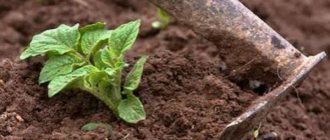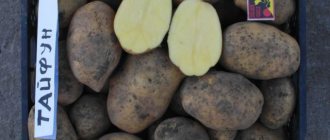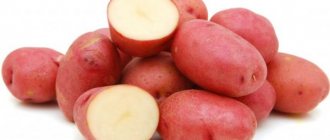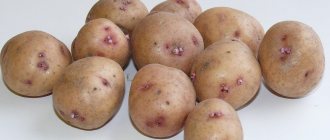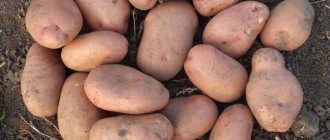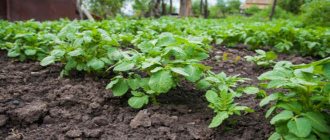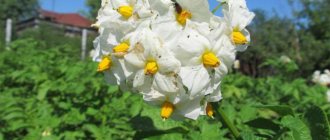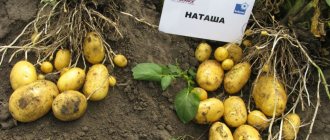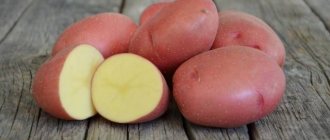Description of the variety
The early ripening potato variety Empress was bred by Russian breeders. These are unpretentious table potatoes . The variety is loved by many summer residents for its unpretentiousness and early ripening.
Origin and development
The originator of the variety is Moscow . The Empress is not included in the State Register and is not zoned. Potatoes are grown from botanical seeds.
Chemical composition, trace elements and vitamins
Potatoes are grown both for private consumption and on an industrial scale.
The calorie content of raw potatoes is 77 kcal per 100 g.
The nutritional value:
- proteins – 2 g;
- fats – 0.4 g;
- carbohydrates – 16.3 g;
- dietary fiber – 1.4 g;
- water – 79 g.
Potatoes are rich in vitamins B6, C, macro- and microelements: potassium, silicon, cobalt, copper, molybdenum, chromium.
What are the beneficial substances contained in potatoes?:
- Vitamin B6 improves metabolism and regulates the content of elements in the blood. Symptoms of vitamin B6 deficiency include decreased appetite and dull skin.
- Vitamin C helps the absorption of iron and participates in redox reactions. Lack of vitamin leads to frequent bleeding.
- Potassium normalizes blood pressure. Takes part in regulating water, acid and electrolyte balance.
- Copper helps in the absorption of proteins and carbohydrates and is involved in iron metabolism. Due to copper, the tissues of the human body are enriched with oxygen. If the amount of the element in the body is insufficient, the functioning of the cardiovascular system is disrupted.
Characteristics of tubers, description of appearance and yield
The tubers have a regular oval shape, yellow flesh and yellow skin . The eyes are not pronounced, which gives the tubers a neat appearance. On average, one potato weighs 70-150 g.
The bush is low, compact, 50 cm high. When planting, it is recommended to maintain a distance between plants of 10-15 cm. The underground part develops well, long, strong root sprouts are formed, on which tubers are formed.
The variety is early ripening. After 2.5 months the first harvest is harvested . One bush produces approximately 8 tubers. The total yield is 300-400 centners per hectare.
Growing in open soil
The plant needs sunlight
The first shoots are small tubers. Add to this feature the compactness of the Empress bushes - it follows that the plants should be planted at a distance of 10-15 cm from each other and half a meter between the rows. But these parameters depend on the number of roots in one hole and other details.
Choose a well-lit hill for planting that is not at risk of waterlogging.
Harvesting and storage
As the tubers ripen and are covered with a tough skin, begin harvesting. Only strong, mature potatoes are ready for wintering. If you are going to store the fruits in the cellar, pre-green them and wash them with a solution of potassium permanganate.
The room temperature should be 2-5 degrees, and the humidity should be as high as possible (95%).
Advantages and disadvantages of the variety
Before growing Empress potatoes, consider all the pros and cons of this variety.
Advantages:
- excellent taste;
- resistance to scab, late blight and nematode;
- double harvest;
- compactness of the bush.
Flaws:
- labor-intensive cultivation;
- low seed germination;
- The seedlings stretch out greatly and lie even on the sunniest windows - additional lighting is required.
Rules for growing seedlings
Experts advise taking seeds from specialized stores, since new varieties will be developed from different species taken from your own gardens. The Empress has its own specifics in growing seedlings.
Since the size of the seeds is quite small, they should not be covered with soil when sowing. Be prepared that sometimes almost half of the seeds do not germinate at all.
Growing from seed
Sow the seeds neatly in a row. Pour the soil into the container with the expectation that you will have to add more as it sprouts. The roots should be on the surface. Some farmers prefer to add sand to the soil to make it more loose. However, this is not the best option because it is too heavy. It is better to use peat or moss. Instead of planting in pots, use the picking method. Flexible plants can be buried in the ground, twisted, etc.
Every 2 weeks, fertilize for 2 months with a special solution. When spring weeds appear, make a solution from them. If May turns out to be warm, start hardening off the plant. Take it outside to a dark place for a couple of hours. Gradually increase the time to 10 hours, and then to a day. Just don’t let the plant freeze.
The best temperature for growing potato crops is 18 °C. When the thermometer drops below zero, the potatoes begin to rot.
Features of planting and growing
Sowing potatoes with botanical seeds begins in early April using the seedling method. The advantage of this method is that the end result is a clean crop free of diseases and viruses .
Seeds for sowing are bought in specialized stores or prepared independently from bulbs that form after potato flowering.
Preparing for landing
Growing potatoes by seeds begins with seedlings . In the case of direct sowing of seeds into the soil, small tubers will be obtained, suitable only for further propagation.
Seeds are prepared in advance:
- In the last days of March, seeds are laid for germination - a damp cloth with seeds is placed in a plastic container.
- Close the container and send it to a warm place near the battery.
- Open the container every day for a few minutes to ventilate.
- If necessary, spray with water - the seeds should be moderately moist.
After the seeds germinate , they are planted in a seedling container filled with nutrient soil.
Important! Seeds are planted in loose soil. Adding sand is not recommended.
Before sowing, the soil is compacted and moistened . After sowing, moisten again with a spray bottle with warm water and place in a warm, sunny place. The seedlings are watered and loosened as needed, and fertilized with complex fertilizer for seedlings.
After a few days, the first shoots appear. And after a month, the seedlings are ready for planting in open ground.
Dates, scheme and rules of planting
Seedlings are planted in open ground from the beginning of May , when the ground has already warmed up.
Soil preparation:
- for planting, choose a place where nightshades did not grow last year in order to avoid contamination of seedlings with diseases and viruses from the soil;
- in the fall they dig up the soil and add organic fertilizers;
- in the spring, add ash and complex fertilizer for potatoes, “Fertika”, “Ogorodnik”.
Since the Empress forms small, compact bushes , row spacing is 40-50 cm, and between plants - 10-15 cm.
Rules for planting potato seedlings:
- when planting, bury the shoot, leaving only the top leaves on the surface;
- carefully lay the long stems at an angle and cover them with earth so that they do not break;
- after planting, water the bed;
- organize a greenhouse to protect plants from frost, pests and sunburn.
The covering material is removed when the seedlings are fully established and the threat of night frosts disappears.
Features of cultivation
Growing potatoes from seeds significantly increases the yield and quality of tubers.
The first crop (mini-tubers) grown from seeds is called the first generation. It has a pronounced taste. In the first year, there is little harvest suitable for food. Basically, all tubers are left for seed and planted in the second year.
Attention! Potato tops begin to grow at +5°C, the optimal temperature for development is +18°C...+25°C. The culture is afraid of low temperatures; at -1°C the above-ground part turns black and dies.
Growing Empress potatoes requires:
- frequent loosening;
- timely watering;
- hilling;
- breaking the crust that forms on the soil after rain;
- frequent weeding;
- spraying;
- fertilizing
Watering mode
Empress needs to be watered during dry periods . Abundant watering is required during budding and flowering.
Top dressing
If the plants turn yellow and grow slowly, they are fed with liquid complex fertilizer - Kemira granules are diluted in water and watered on the potatoes. This saturates the soil with nitrogen, potassium and phosphorus.
During the period of bud formation, add a solution of 1 tbsp. l. potassium sulfate and 3 tbsp. l. ash in 10 liters of water - 500 ml per plant. During flowering, dissolve 2 tbsp in a bucket of water. l. superphosphate and cow manure and water 500 ml per bush.
Disease and pest control
Potato Empress is resistant to:
- potato nematode;
- fungal diseases;
- common scab.
When the Colorado potato beetle appears, the bushes are treated with a special preparation “Aktara”, and to prevent late blight - “Fitosporin”.
Over time, the tubers accumulate diseases , and yields begin to decline. This serves as a reason to update the seed material.
Difficulties in growing
Empress seed tubers cannot be found for sale; they are not even in the SeDek catalogue. You will have to buy botanical seeds in bags and grow them in seedlings.
Difficulties arise already at the stage of growing seedlings:
- half of the seeds do not germinate;
- many of those that have sprouted begin to darken at the roots and die;
- the seedlings are stretching too thin.
Caring for seedlings, watering and installing an additional light source will help solve problems.
Reasons for the slow development of the Empress in open ground:
- violation of crop rotation rules;
- not enough fertilizer has been applied;
- plants are damaged by frost;
- not enough loosening;
- a lot of weeds;
- the appearance of pests and diseases.
Potato care
As soon as the soil begins to dry out, feed the plant with water.
This is especially important during the flowering period. Feed with manure, bird droppings, weeds
Spud up. The variety, being quite unpretentious, does not require any special effort and grows well on its own. But, if the fruits are grown for sale, you need to apply techniques using agricultural technology. Then you are guaranteed to get a high yield of marketable potatoes.
After the hilling procedure, you can begin weed control using chemicals - but strictly two days before the first shoots. Use a proven product that destroys annual, perennial, and dicotyledonous weeds. Neon-99 and Remus are best suited - 250 liters per hectare.
During the budding period, the plant needs special watering, with the addition of fertilizers. Hilling and loosening of the soil is carried out three times per season. Such processes ensure the flow of air into the rhizome and increase the intensity of club formation.
Before digging potatoes, mow the tops. After digging up the tubers, dry them in a well-ventilated room, but avoid direct exposure to sunlight. Before being sent for storage, the crop is chemically treated.
Harvest and storage
To prevent the tubers from starting to wither and get sick, as well as to preserve good seed when storing, a number of rules must be followed .
Important! To withstand long-term winter storage, the tubers must be ripe and have a thick skin.
How and when to collect
The Empress harvest is carried out in two stages :
- For consumption - in mid-summer, about 2 months after planting. Carefully dig up the bush, take out the ripe tubers, and sprinkle the roots with soil.
- For storage - in the fall, at the end of September - beginning of October.
Storage features and keeping quality of the variety
Before storing the potatoes, dry them well and ventilate them . Potatoes must be stored in a dark place at a temperature of +3°C. A basement or cellar is used for these purposes.
The variety has good shelf life during winter storage and retains excellent taste until spring.
Application and beneficial properties
The purple and blue color of the vegetable is given by a plant pigment – anthocyanin. This is a substance with bactericidal properties. But in addition to anthocyanin, the product contains a number of other nutrients that have a positive effect on the human body.
In cooking
The product is readily used by chefs in restaurants, as it not only has a bright pigment, but also an aftertaste that is not characteristic of white varieties. For this reason, they are called truffle potatoes. The root vegetable with the flavor of walnuts and hazelnuts goes well with vegetable salads, fish, and meat.
- Potato baskets
- baked potato
The product will bring the greatest benefit when baked. To do this, the root vegetables are washed, cut into 4-6 parts (the peel is not removed), and olive or sunflower oil is added. Then put it in the oven for 20 minutes at a temperature of +170°C. 5-7 minutes before readiness, add salt and herbs. Rosemary, dill, and dry garlic go well with the crop.
When cooking, it is important not to overcook the product so that the potatoes do not become overcooked or lose their shape and color. You can check for doneness with a knife or toothpick.
The product should be slightly firm. For frying, mid-season and late varieties of the crop are used. Early varieties are preferably consumed raw and baked.
Pancakes, casseroles, gratins, and chips are prepared from purple potatoes. Italian purple gnocchi will arouse the interest of gourmets. Children will be surprised and delighted by purple mashed potatoes or dumplings with blue filling.
Purple Potato Chips
The vegetable is allowed in dietary nutrition, since its starch content is lower than in other varieties
After consuming the product, the blood sugar level does not rise sharply, but gradually, which is important for diabetics. The calorie content of the dish will be lower if the product is not digested
Snack recipe: boil the vegetable, grate it on a coarse grater, add salt, sesame oil, spices to taste and 1-2 tablespoons of sour cream or mayonnaise. Spread on crispy toast and garnish with fresh herbs.
In medicine
The following elements were identified in the chemical composition of the product:
- B vitamins (B1, B1, B5, B6, B9);
- vitamins A, C, PP, E, K;
- alimentary fiber;
- macroelements (potassium, magnesium, phosphorus, sulfur and others);
- ash.
Energy value per 100 g – 70 Kcal. The high content of vitamin A and C replenishes the daily dose of these elements in the human body. Ascorbic acid helps absorb iron, which prevents anemia.
Potatoes with purple flesh contain antioxidants that reduce the risk of atherosclerosis and myocardial infarction. The functioning of the cardiovascular system improves.
Minerals support the immune system, give energy and tone. For eye diseases, such as myopia, cataracts, glaucoma, beneficial substances reduce the load on the retina. This occurs largely due to thiamine, antioxidants, and vitamin A.
Doctors recommend including colored root vegetables in your diet if you have high blood pressure, as it helps lower it. For people with digestive problems in remission, the root vegetable is indicated in limited quantities. It reduces stomach acidity, normalizes intestinal motility, and reduces flatulence.
Reviews of the Empress variety
Many gardeners experiment with growing this variety and share their feedback.
Olga, Sosnovy Bor : “I accidentally saw a description of the Empress potato variety and a photo of compact bushes, and decided to plant it, since the garden is small. The potatoes grow very even and beautiful, but voids are formed, although only slightly. More resistant to scab than Adretta.”
Mark, Samara : “I grew the early ripening Empress variety from seeds. Of course, this is not an easy matter. First, I germinated the seeds and planted them in seedling boxes, just like tomatoes. At the end of April, I planted seedlings in box beds in the greenhouse, then transferred the seedlings to open ground. The care is normal. In the first season I collected all the tubers, even small ones. It is very important to save the seed until spring. This year I planted potatoes, planting 4-5 per hole at a time. The result justified all my efforts. We managed to collect a 10-liter bucket of excellent potatoes from three bushes.”
Characteristics of Empress potatoes
Today, new potato varieties are constantly appearing, so it is important to find out what their advantages are before you try to grow them in your own country house. According to the description of the variety, photos and reviews, Empress potatoes are classified as early ripening and high-yielding
Find out more about this species and try planting seeds or tubers in your garden.
Read: Impala potatoes, description and reviews
Description of the Empress potato variety
Empress potato tubers have an oval shape, thin yellow skin and yellow flesh. This variety is early ripening, and with proper hilling at the beginning of summer, you will be able to harvest an additional harvest in the fall. The average fruit weight is from 70 to 150 grams, and you will receive the first harvest after 2.5 months. The period of full ripening is 90 days.
According to the description of the Empress potato, this variety is resistant to potato nematode, scab and late blight. It is thanks to these characteristics that the Empress is in demand among summer residents.
Potato bushes are quite tall, up to 80 cm, and spreading, so it is worth maintaining a distance between them of 20 to 50 cm. Planting can be done in May, in which case you will receive the fruits in July or August. It is worth setting aside a well-lit area for planting, then the plant will develop normally and will delight you with a bountiful harvest.
Features of care and planting of Empress potatoes
To protect the crop from various diseases, it is necessary to pre-treat the tubers with a special solution, for example, TMTD. Dilute the mixture according to the manufacturer's instructions
It is important to prepare the area itself to get rid of weed seeds and roots.
Be sure to add fertilizer to the planting hole to speed up the potato germination process. You need to care for Empress potatoes the same way as any other varieties.
- Carry out regular hilling.
- Spray the tops against pests.
- Water in a timely manner.
Before digging up Empress potatoes, according to reviews from summer residents, it is necessary to mow the tops. After this, you can dig up the tubers and spread them out to dry. If you plan to store potatoes for a long time, then treat them with special compounds that will protect against various types of damage.
The Empress potato, according to the description of the variety, as well as photos and reviews of gardeners and those who planted it, deserves special attention among those who plan to plant an early-ripening table variety. Grow different types of potatoes, then you can decide which one you like best.
